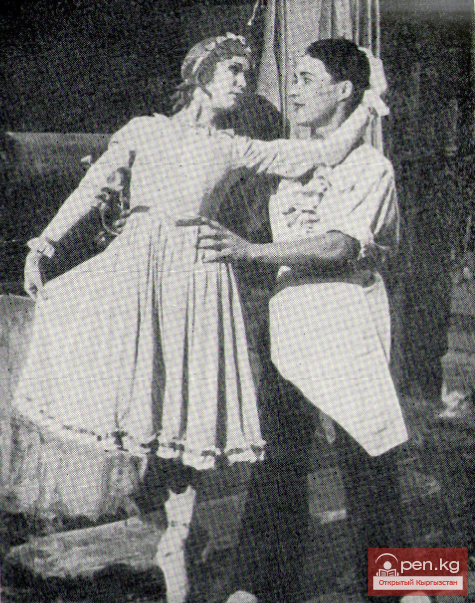
DZHUMAKALYY ARSYGULOVA
This name of the first Kyrgyz professional ballerina stands at the origins of Kyrgyz ballet art. Her life and creative path were short. She debuted on the stage of the Kyrgyz Theater in Frunze in August 1941, and died in April 1947. At that time, the actress was 25 years old, and her talent was just beginning to blossom. However, the significance of D. Arsygulova in the history of Kyrgyz theater is not measured solely by the few years she dedicated to art. Her activity had a beneficial influence on the development of professional ballet art in Kyrgyzstan, and the image of a great worker and an advanced, good person remains in the memory of all who knew her, those fortunate enough to come into contact with the inspired mastery of this remarkable ballerina.
Dzhumakalyy Arsygulova was born in the village of Belogorka in the present Sokuluk district into a peasant family. She was the eldest among the children. She managed to instill such respect in her younger siblings that no one challenged her authority. Even then, a strong character was evident in Dzhumakalyy, which clearly manifested in the following years.
As a girl, she moved to Frunze, where she studied at school and then entered a medical college. But it seemed that medicine did not attract Dzhumakalyy, and soon she had the determination to leave the college. That year, the first group of children was being recruited for study at the Leningrad Choreographic School. To confess, she was somewhat frightened by the prospect of leaving home, but a joyful perspective loomed before Dzhumakalyy, and she decided to go to Leningrad. She was accompanied by other boys and girls, but she especially became friends with Gulbara Daniyarova.
Thus, they remained friends.
In Leningrad, from the very first days, Dzhumakalyy amazed her instructors with her diligence and persistence. She studied excellently, better than anyone in her group, and, as in childhood, became a recognized authority. Instead of her long name, Dzhumakalyy was called Sasha, and she liked it very much.
Dzhumakalyy also stood out in the main aspect — professional growth. This is usually revealed in the process of many years of work, but she showed traits of true artistry even in school. In 1941, she was the first among the students to graduate from the Leningrad Choreographic School, returned to her hometown, and was enrolled as a soloist in the Kyrgyz Musical Theater. From that time, she led all the main roles in new ballet performances of the theater and also participated in productions staged shortly before her arrival. These included "The Rivals" by P. Gertel and "Coppélia" by L. Delibes. In the first performance, she played the role of the maid Lisa. The classical ballet of P. Gertel provided the actress with an opportunity to showcase her professional training. The previously successful performer in this ballet, Dzhuken Djabieva, did not possess the technical mastery. An excellent ballerina by her natural abilities, D. Djabieva clearly fell short of the new performer in the culture of execution — this was noticeable to everyone as soon as D. Arsygulova appeared on stage. Her Lisa was an enchanting being. The transformation of a simple peasant girl into a noble daughter with effortlessly sophisticated manners seemed completely natural in Dzhumakalyy's performance. As is known, the performance "The Rivals" was staged in 1939 with the aim of raising the technical level of young ballet artists and developing their professional skills. In this sense, the example of D. Arsygulova had great educational significance for her less experienced colleagues.
In "Coppélia," D. Arsygulova danced Swanhilda. She brought into this role the qualities that were characteristic of Lisa from "The Rivals" — natural intelligence, cunning, and the ability to stand up for herself. When Swanhilda learns that her fickle fiancé Franz has decided to betray her and try his luck with the beloved doll of the old scholar Coppélius, she sneaks into his house and, dressed in the doll's dress, stages her "revival." In the way the "doll" behaved, there was much that was amusing and entertaining, but most importantly — D. Arsygulova unfolded a cascade of the most diverse movements in this role — pirouettes, jumps, fouettés — all performed with such lightness as if she had wings that allowed her to soar above the stage.
Simultaneously with the roles of Lisa in "The Rivals" and Swanhilda in "Coppélia," D. Arsygulova was working on the upcoming production of "Laurensia" by A. Krein. In this role, which became a peak for her, the young ballerina invested all her skill, technicality, and passion of the soul.
Ballet











































